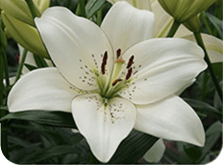Lilies on the map
Foreign horticultural professionals can smoothly combine two important events in June: after the Dutch Lily Days (7 through 10 June), they are welcome to attend the Flower Trials (14 through 17 June). In a relatively brief period, international visitors get a good impression of the complete Dutch floricultural programme.
Lilies on the map
Many consumers point to the intensely staining pollen as a disadvantage of this flower. The first pollen-free variety, Oriental Tiara, has been around already for over 30 years, and the consumer is asking for a wider range of pollen-free varieties. The demand for these kinds of lilies is huge and global.
It is not easy to breed pollen-free lilies. The participants in the Dutch Lily Days exert themselves to meet the global demand and display their innovative side during this annual event. This tenth edition will acquaint visitors with new, often brighter colours and more resistant varieties. In addition, breeders show what their search for longer vase life and greater number of buds has led to. By combining forces, the Dutch lily sector puts lilies more clearly on the map during the Dutch Lily Days.
Scope and impact
It seems that after the Corona outbreak, a number of bulb growers decided to downsize their production. Together with a somewhat disappointing bulb harvest given the weather conditions in 2021 and an early recovery of the demand for bulbs, a shortage was noted on the market last year. It is expected in the coming year that the supply will again match the market demand, and that offers possibilities for expansion and innovation.
Participants
Thirteen participants around the country are launching their participation in the Dutch Lily Days at the same time. The event for professional colleagues is being held at P. Aker, Van den Bos Flowerbulbs, Bot Flowerbulbs, De Jong Lelies, Lily Company, Onings Holland, C. Steenvoorden, GAV’s Lilies, Gebr. Vletter & Den Haan, VWS Flowerbulbs, World Breeding, Zabo Plant and Royal Van Zanten.




